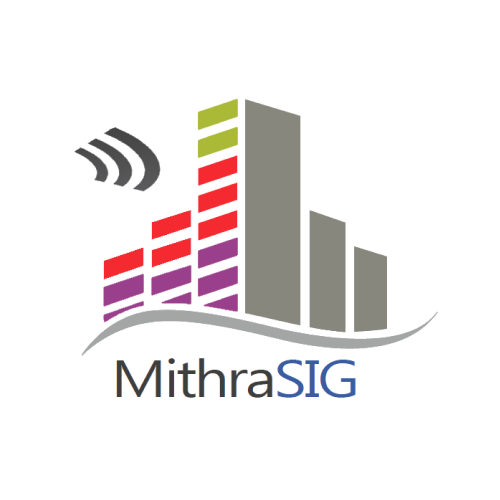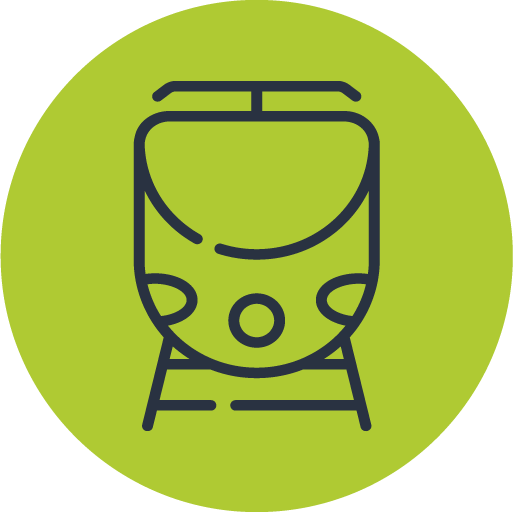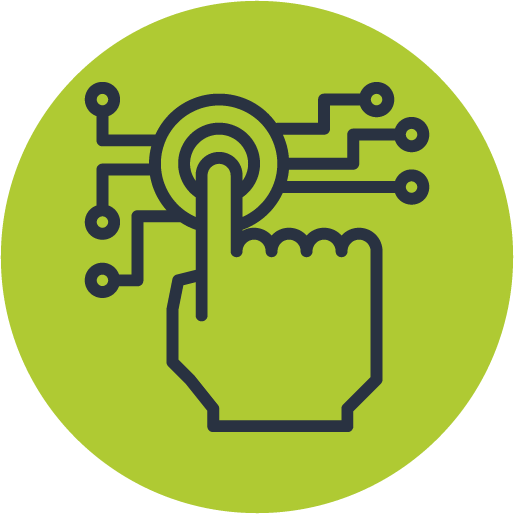MithraSIG, acoustic simulation software for outdoor environments
Noise mapping, simulating the propagation of acoustic waves in an outdoor environment
The European directive on the management of environmental noise, as well as French regulations, now require the production of strategic noise maps in order to limit and prevent noise pollution in the vicinity of certain road, motorway and rail infrastructures, as well as in certain conurbations. Environmental noise has become a major issue at national level and in other countries. More and more laws are being passed requiring acoustic studies to be carried out.
Assessing noise impacts using noise mapping
MithraSIG is a GIS-based acoustic simulation software. The Geographic Information System (GIS) provides openness and durability, with a wide-range of formats maintained for both reading and exporting, advanced drawing and editing features, analysis and rendering. The GIS used is Cadcorp SIS, which was initially chosen by IGN on behalf of CSTB.
The software has a broad scope of application, modelling noise pollution in the vicinity of road, motorway and rail infrastructures, as well as noise from building sites, wind farms, ports and any other neighbourhood noise (point sources, etc.).The tool also determines the proportion of the population

A sound mapping solution resulting from the collaboration of two experts

MithraSIG is the result of collaboration between 2 specialists in their field: The CSTB (Scientific and Technical Center for Building), a recognised expert with 40 years of research in acoustics - Page 3 / 8 the MITHRA code - provides calculation engines representing the state of the art in terms of rigour and performance.
Geomod, an expert in geomatics, renowned for its fast response times in development and the quality of its user support, provides its development and integration expertise.
High-performance, ultra-complete acoustic mapping software

A simple, comprehensive package
Because you have a wide range of needs, all types of sources are included from the first licence level , so you can carry out all types of acoustic simulation projects : road, rail and industrial sources, ray tracing, data analysis and cross-referencing. The only limitation is the number of objects.
Railway and tramway sources use the SNCF's database of railway convoys.
Industrial sources (point, line, facade or surface) use the Imagine database (European project) and offer more than 1,200 sources.

Fast, rigorous calculations
Drawing on the expertise of CSTB, MithraSIG combines speed and precision in its calculations.
MithraSIG's acoustic wave propagation simulations use high-performance algorithms based on asymptotic methods such as ray tracing and adaptive beam tracing.
By design, the algorithms used are suitable for forecasting in a closed environment, such as the centre of a city with a high building density, as well as in an open environment with vast spaces between buildings, or in mountainous sites where the ground relief influences propagation.
MithraSIG benefits from the expertise and Research and Development work of the CSTB.

Compliance with standards
The physical calculation engine calculates noise propagation in accordance with the requirements of current regulations, in particular European Directive 2002/49/EC, taking into account the effects of meteorological conditions.
Geometric engines ranging from fast ray tracing to beam tracing for diffraction on the vertical edges of objects.
64-bit multi-processor computing (multithreading) using the latest available technologies.
Calculation methods: CNOSSOS-EU, NMPB2008 (octave and 1/3 octave), ISO9613, NMPB96 (XP S31- 133), Harmonoise (1/3 octave).
A solution tailored to the size of your projects
MithraSIG is just as suitable for simulating the acoustics of a project in a town, conurbation or department as it is for carrying out an impact study and a local noise prevention plan.

Because every project is different, several licence levels are available, based on the number of objects taken into account in the calculation model (excluding terrain):
- Up to 100 objects.
- Up to 1,000 objects.
- Up to 10,000 objects.
- Up to 100,000 objects.
- Unlimited objects.
A simple, intuitive interface
MithraSIG has been designed so that you can easily create your model.
Thanks to a simple and intuitive interface, model creation is fast. It can be created either by integrating data from different organisations, in different forms and formats, or manually using the drawing tools.
- Over 160 formats supported (SHP, MIF/MID, TAB, DXF, DWG, DGN, etc.).
- Automatic project creation from SRTM and OpenStreetMap data, enabling you to create acoustic simulation projects quickly.
- Advanced tools for creating and editing objects that take full advantage of the richness of GIS.
- Dedicated wizards for creating themes, spatial queries and printouts.
MithraSIG allows you to create both vector and raster renderings with an extremely sophisticated map creation tool. Simple tickboxes can be used to define all the parameters of a map: indices, sources, frequencies, colour palette, rendering type and accuracy. The map display changes in real time as these parameters are modified. So it's easy to set up and create your map quickly
- 4 types of mapping: vertical, horizontal, building facades and userpositioned receiver maps.
- Presentation of results in the form of tables, maps, cross-sections and 3D views.
- Real-time updates after traffic modifications, index changes, source activation/deactivation, etc.
- Creation of differential maps (before/after installation of infrastructure, increase/decrease in traffic or speed, etc.).
Decision-making and communication support
MithraSIG stands out for the quality of the documents produced during acoustic simulation, in particular the dynamic PDFs (with layers, diagrams and geo-referencing). The small size of the PDF files allow the renderings produced to be transferred by e-mail.
In addition, MithraSIG also enables the maps produced to be distributed in a variety of formats, including:
- Export to KMZ, which allows, among other things, visualisation in Google Earth™.
- Export to software for real-time fly-through of virtual models.
- Export to over 50 formats, both vector and raster (SHP, TAB, ECW, JPEG, TIFF, BIL, etc.).
MithraSIG can also be used to measure the acoustic impact of future projects in terms of the population affected. The 2D and 3D maps are fantastic communication tools. They provide an objective opinion in public debates linked to a new infrastructure or a new development

David Collado. I joined the Geomod team at Coexya at the end of May. My main objective at the moment is to continue developing a software package called MithraSIG, which is used for noise mapping.
What does the MithraSIG software consist of?
MithraSIG is a software package that was developed 17 years ago. It is already well established on the French market. MithraSIG is the result of a collaboration between Geomod and the CSTB, a French research and development organisation, which enabled us to base the software on very solid scientific foundations. MithraSIG is a decision-making tool that can be used to meet legislative requirements, which are increasingly taking into account the needs of city dwellers. Europe is a driving force in this respect. Over the last few years, we have implemented European standards that are already effective.
What is the strong point of the MithraSIG software?
The team's dynamism and the fairly close links we have with various partners in France, including SNCF, CEREMA and CSTB, have enabled us to implement various noise indicators that are being assessed by the government.
A few words about the future of the software?
For the future development of MithraSIG, we're going to work on improving the ergonomics, perhaps providing more tools for analysing and comparing the different scenarios we're able to create within the same model. Ensuring that our users can easily obtain their models, export them and analyse them, at an ever finer granularity. We are also going to work on enriching our database by integrating more new noises, for example, by enriching the wind component. This is an issue that is developing in the region. We're also going to work on improving the noise emitted by various industries. We've also done a lot of work on simulating ship noise in ports. We're going to try to improve the accuracy of our simulations of industrial sources, wind turbines and others.
Watch the highlights of the MithraSIG 2025 user morning
On 15 May, we organised a morning dedicated to MithraSIG's new products and concrete feedback on ambitious acoustic projects.
🎥 The replays in french to discover :
- Rail event indicators in MithraSIG
Florence Minard – AcoustB 👉
- Strategic Noise Map, DTM, noise barriers and traffic parameters
Arnaud Leung-Tack – Acoucité 👉
- Dynamic noise mapping of the Paris ring road
Manuel Helot – Bruitparif 👉
- MithraSIG outlook and future developments
New modules & upcoming events (RIAC 2025)
David Collado –Geomod by Coexya 👉
MithraSIG Users' Morning 2024
Discover the replay of our user morning which took place on 2024 to (re)discover the new functions of the MithraSIG software, share best practices, suggest improvements and create synergies between users.
During this Webinar, 3 users presented their projects and use cases:
- Mathieu Laulom from CEREMA presented his use of the Atlas.
- Damien Garnier, from the consultancy Conseil Ingénierie Acoustique, talked about table views associated with spatial joins.
- Toscan Gaven from Espace 9 presented his method for calibrating a model against measurements.
Finally, the 2 Geomod experts, David Collado and Jean-Benoit Dufour, presented the latest developments in the software.